Leadership Competency: Enhancing Change Through Adaptability
VerifiedAdded on 2020/05/01
|8
|2083
|63
Essay
AI Summary
This essay delves into the critical leadership competencies required for initiating and managing change within contemporary organizations. It emphasizes the importance of adaptability, innovation, and relationship-building as core skills. The essay explores the concept of adaptability, including interpersonal and cultural adaptability, and the ability to solve problems creatively. It also examines the role of innovation in fostering collaboration and managing conflict, as well as the development of strong relationships with stakeholders. The author highlights the significance of self-awareness, active listening, and intuition in understanding and responding to the diverse needs of stakeholders. The essay references key leadership theories and provides practical suggestions for developing these competencies, ultimately aiming to equip leaders with the tools to effectively navigate organizational change and promote positive outcomes. The essay highlights that in order to be a good leader you need to be able to adapt to change and also allow for feedback from others.
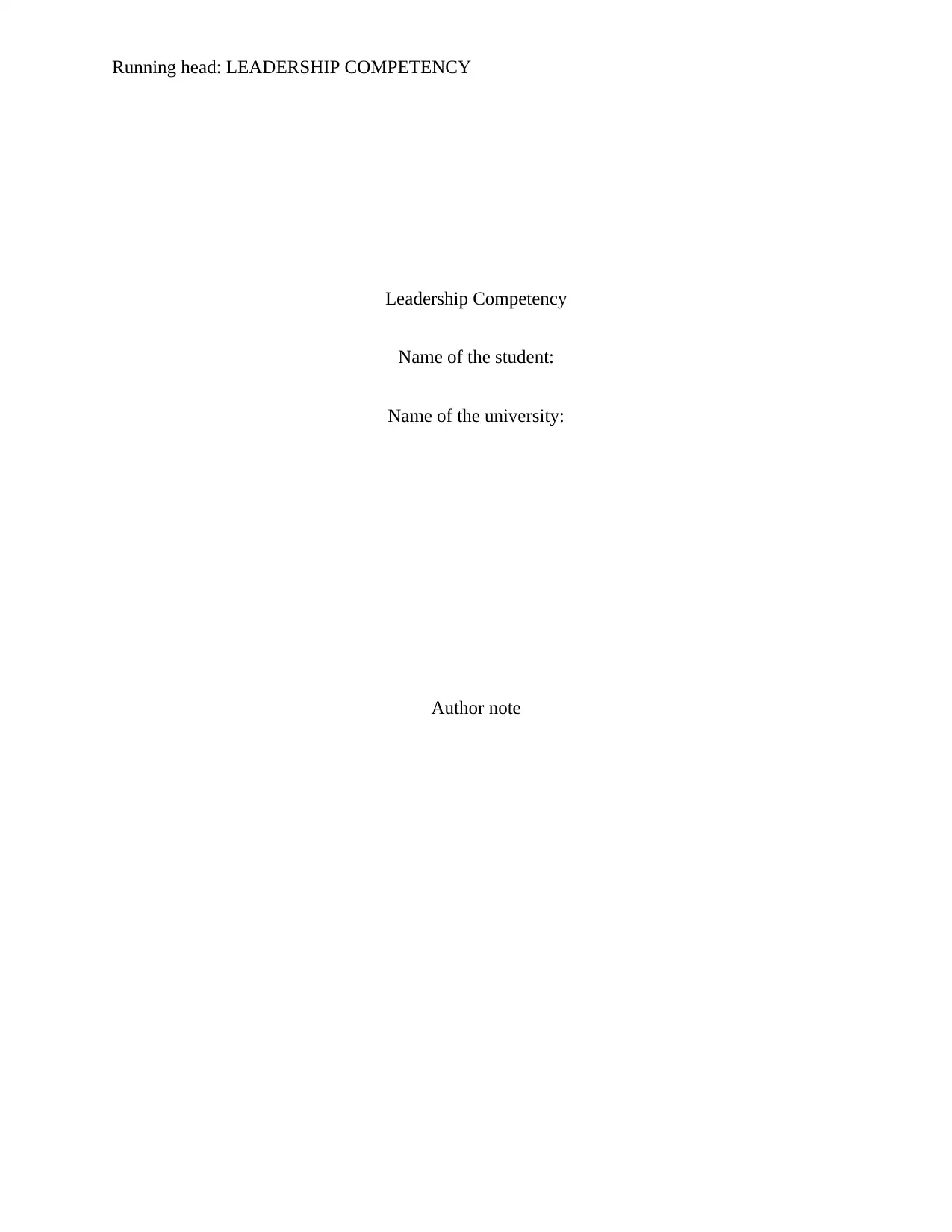
Running head: LEADERSHIP COMPETENCY
Leadership Competency
Name of the student:
Name of the university:
Author note
Leadership Competency
Name of the student:
Name of the university:
Author note
Paraphrase This Document
Need a fresh take? Get an instant paraphrase of this document with our AI Paraphraser
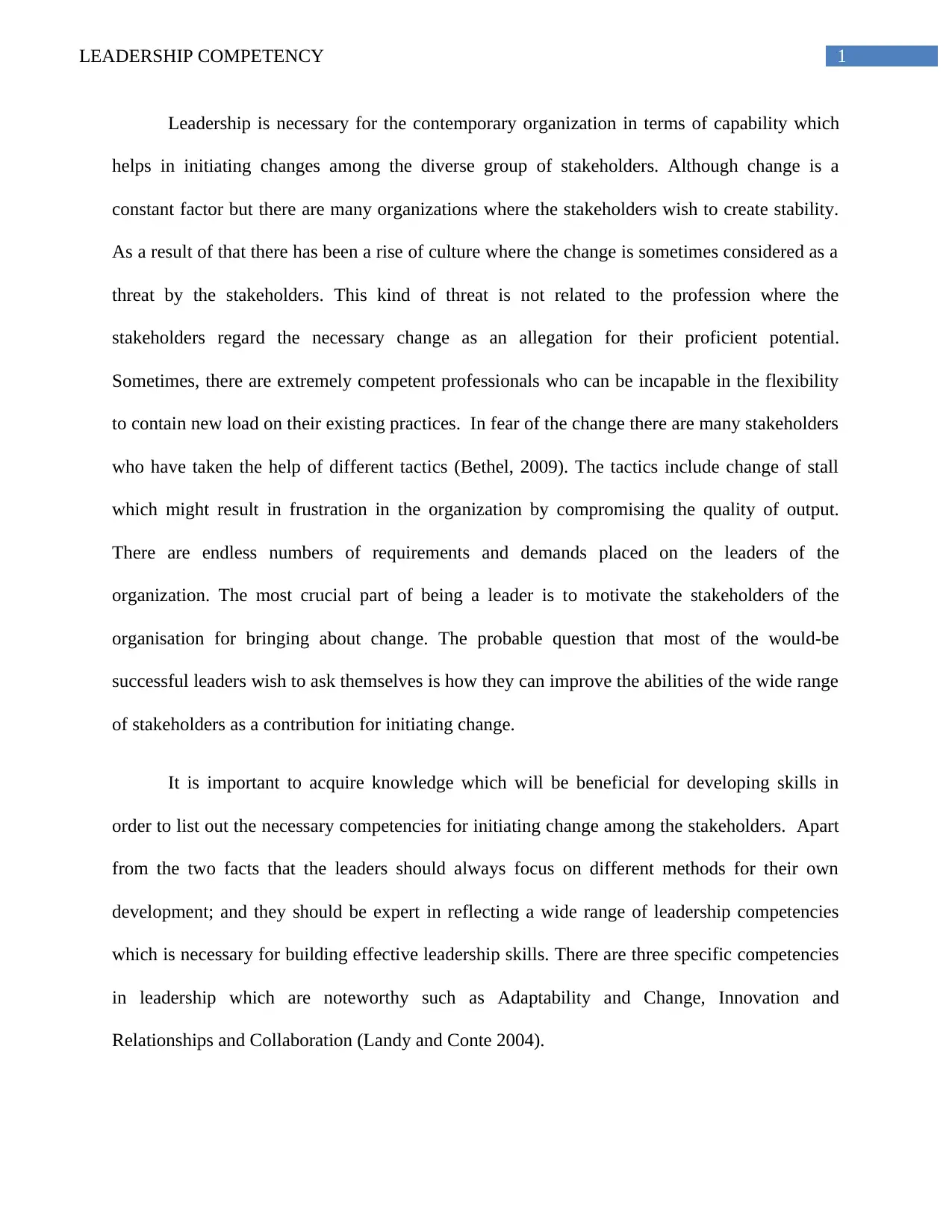
1LEADERSHIP COMPETENCY
Leadership is necessary for the contemporary organization in terms of capability which
helps in initiating changes among the diverse group of stakeholders. Although change is a
constant factor but there are many organizations where the stakeholders wish to create stability.
As a result of that there has been a rise of culture where the change is sometimes considered as a
threat by the stakeholders. This kind of threat is not related to the profession where the
stakeholders regard the necessary change as an allegation for their proficient potential.
Sometimes, there are extremely competent professionals who can be incapable in the flexibility
to contain new load on their existing practices. In fear of the change there are many stakeholders
who have taken the help of different tactics (Bethel, 2009). The tactics include change of stall
which might result in frustration in the organization by compromising the quality of output.
There are endless numbers of requirements and demands placed on the leaders of the
organization. The most crucial part of being a leader is to motivate the stakeholders of the
organisation for bringing about change. The probable question that most of the would-be
successful leaders wish to ask themselves is how they can improve the abilities of the wide range
of stakeholders as a contribution for initiating change.
It is important to acquire knowledge which will be beneficial for developing skills in
order to list out the necessary competencies for initiating change among the stakeholders. Apart
from the two facts that the leaders should always focus on different methods for their own
development; and they should be expert in reflecting a wide range of leadership competencies
which is necessary for building effective leadership skills. There are three specific competencies
in leadership which are noteworthy such as Adaptability and Change, Innovation and
Relationships and Collaboration (Landy and Conte 2004).
Leadership is necessary for the contemporary organization in terms of capability which
helps in initiating changes among the diverse group of stakeholders. Although change is a
constant factor but there are many organizations where the stakeholders wish to create stability.
As a result of that there has been a rise of culture where the change is sometimes considered as a
threat by the stakeholders. This kind of threat is not related to the profession where the
stakeholders regard the necessary change as an allegation for their proficient potential.
Sometimes, there are extremely competent professionals who can be incapable in the flexibility
to contain new load on their existing practices. In fear of the change there are many stakeholders
who have taken the help of different tactics (Bethel, 2009). The tactics include change of stall
which might result in frustration in the organization by compromising the quality of output.
There are endless numbers of requirements and demands placed on the leaders of the
organization. The most crucial part of being a leader is to motivate the stakeholders of the
organisation for bringing about change. The probable question that most of the would-be
successful leaders wish to ask themselves is how they can improve the abilities of the wide range
of stakeholders as a contribution for initiating change.
It is important to acquire knowledge which will be beneficial for developing skills in
order to list out the necessary competencies for initiating change among the stakeholders. Apart
from the two facts that the leaders should always focus on different methods for their own
development; and they should be expert in reflecting a wide range of leadership competencies
which is necessary for building effective leadership skills. There are three specific competencies
in leadership which are noteworthy such as Adaptability and Change, Innovation and
Relationships and Collaboration (Landy and Conte 2004).
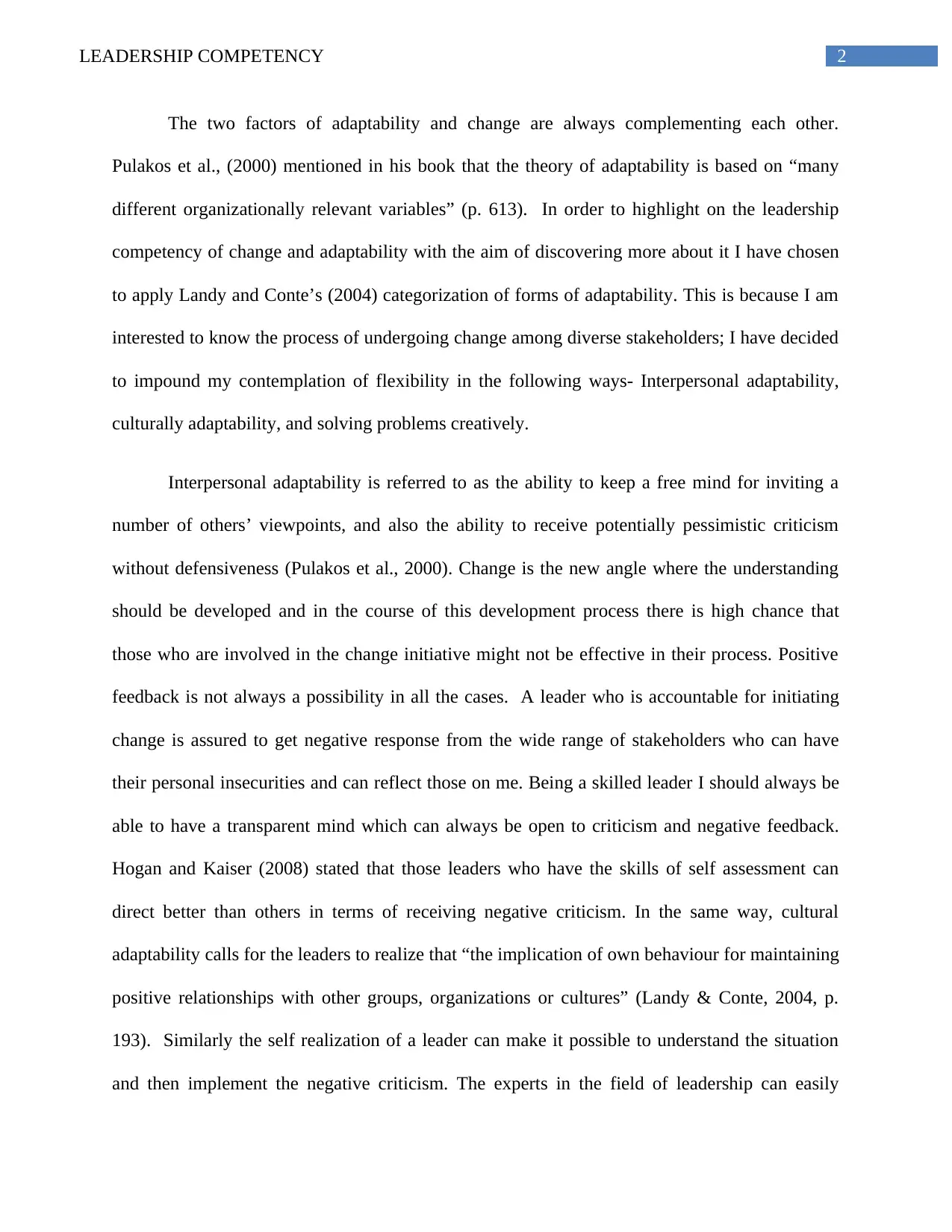
2LEADERSHIP COMPETENCY
The two factors of adaptability and change are always complementing each other.
Pulakos et al., (2000) mentioned in his book that the theory of adaptability is based on “many
different organizationally relevant variables” (p. 613). In order to highlight on the leadership
competency of change and adaptability with the aim of discovering more about it I have chosen
to apply Landy and Conte’s (2004) categorization of forms of adaptability. This is because I am
interested to know the process of undergoing change among diverse stakeholders; I have decided
to impound my contemplation of flexibility in the following ways- Interpersonal adaptability,
culturally adaptability, and solving problems creatively.
Interpersonal adaptability is referred to as the ability to keep a free mind for inviting a
number of others’ viewpoints, and also the ability to receive potentially pessimistic criticism
without defensiveness (Pulakos et al., 2000). Change is the new angle where the understanding
should be developed and in the course of this development process there is high chance that
those who are involved in the change initiative might not be effective in their process. Positive
feedback is not always a possibility in all the cases. A leader who is accountable for initiating
change is assured to get negative response from the wide range of stakeholders who can have
their personal insecurities and can reflect those on me. Being a skilled leader I should always be
able to have a transparent mind which can always be open to criticism and negative feedback.
Hogan and Kaiser (2008) stated that those leaders who have the skills of self assessment can
direct better than others in terms of receiving negative criticism. In the same way, cultural
adaptability calls for the leaders to realize that “the implication of own behaviour for maintaining
positive relationships with other groups, organizations or cultures” (Landy & Conte, 2004, p.
193). Similarly the self realization of a leader can make it possible to understand the situation
and then implement the negative criticism. The experts in the field of leadership can easily
The two factors of adaptability and change are always complementing each other.
Pulakos et al., (2000) mentioned in his book that the theory of adaptability is based on “many
different organizationally relevant variables” (p. 613). In order to highlight on the leadership
competency of change and adaptability with the aim of discovering more about it I have chosen
to apply Landy and Conte’s (2004) categorization of forms of adaptability. This is because I am
interested to know the process of undergoing change among diverse stakeholders; I have decided
to impound my contemplation of flexibility in the following ways- Interpersonal adaptability,
culturally adaptability, and solving problems creatively.
Interpersonal adaptability is referred to as the ability to keep a free mind for inviting a
number of others’ viewpoints, and also the ability to receive potentially pessimistic criticism
without defensiveness (Pulakos et al., 2000). Change is the new angle where the understanding
should be developed and in the course of this development process there is high chance that
those who are involved in the change initiative might not be effective in their process. Positive
feedback is not always a possibility in all the cases. A leader who is accountable for initiating
change is assured to get negative response from the wide range of stakeholders who can have
their personal insecurities and can reflect those on me. Being a skilled leader I should always be
able to have a transparent mind which can always be open to criticism and negative feedback.
Hogan and Kaiser (2008) stated that those leaders who have the skills of self assessment can
direct better than others in terms of receiving negative criticism. In the same way, cultural
adaptability calls for the leaders to realize that “the implication of own behaviour for maintaining
positive relationships with other groups, organizations or cultures” (Landy & Conte, 2004, p.
193). Similarly the self realization of a leader can make it possible to understand the situation
and then implement the negative criticism. The experts in the field of leadership can easily
⊘ This is a preview!⊘
Do you want full access?
Subscribe today to unlock all pages.

Trusted by 1+ million students worldwide
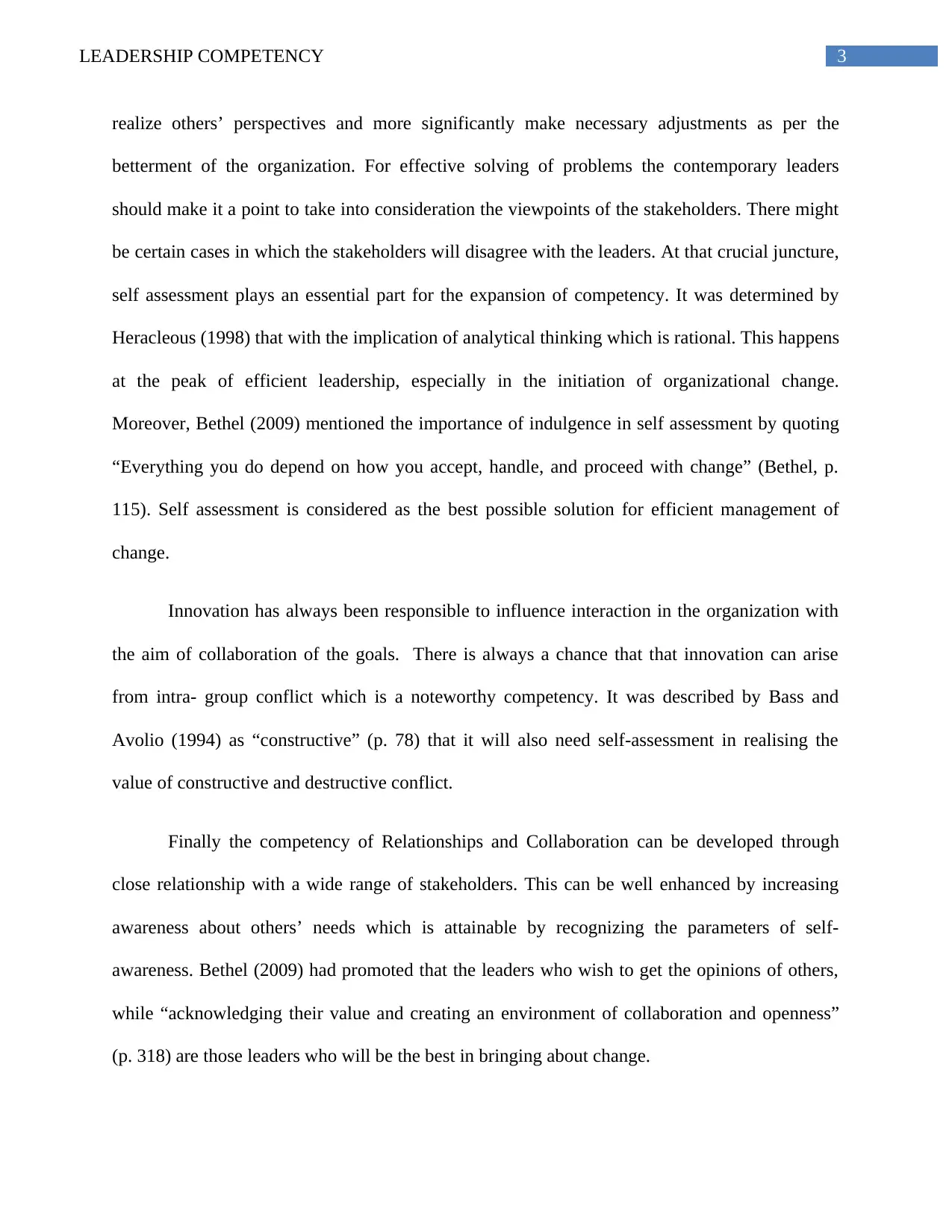
3LEADERSHIP COMPETENCY
realize others’ perspectives and more significantly make necessary adjustments as per the
betterment of the organization. For effective solving of problems the contemporary leaders
should make it a point to take into consideration the viewpoints of the stakeholders. There might
be certain cases in which the stakeholders will disagree with the leaders. At that crucial juncture,
self assessment plays an essential part for the expansion of competency. It was determined by
Heracleous (1998) that with the implication of analytical thinking which is rational. This happens
at the peak of efficient leadership, especially in the initiation of organizational change.
Moreover, Bethel (2009) mentioned the importance of indulgence in self assessment by quoting
“Everything you do depend on how you accept, handle, and proceed with change” (Bethel, p.
115). Self assessment is considered as the best possible solution for efficient management of
change.
Innovation has always been responsible to influence interaction in the organization with
the aim of collaboration of the goals. There is always a chance that that innovation can arise
from intra- group conflict which is a noteworthy competency. It was described by Bass and
Avolio (1994) as “constructive” (p. 78) that it will also need self-assessment in realising the
value of constructive and destructive conflict.
Finally the competency of Relationships and Collaboration can be developed through
close relationship with a wide range of stakeholders. This can be well enhanced by increasing
awareness about others’ needs which is attainable by recognizing the parameters of self-
awareness. Bethel (2009) had promoted that the leaders who wish to get the opinions of others,
while “acknowledging their value and creating an environment of collaboration and openness”
(p. 318) are those leaders who will be the best in bringing about change.
realize others’ perspectives and more significantly make necessary adjustments as per the
betterment of the organization. For effective solving of problems the contemporary leaders
should make it a point to take into consideration the viewpoints of the stakeholders. There might
be certain cases in which the stakeholders will disagree with the leaders. At that crucial juncture,
self assessment plays an essential part for the expansion of competency. It was determined by
Heracleous (1998) that with the implication of analytical thinking which is rational. This happens
at the peak of efficient leadership, especially in the initiation of organizational change.
Moreover, Bethel (2009) mentioned the importance of indulgence in self assessment by quoting
“Everything you do depend on how you accept, handle, and proceed with change” (Bethel, p.
115). Self assessment is considered as the best possible solution for efficient management of
change.
Innovation has always been responsible to influence interaction in the organization with
the aim of collaboration of the goals. There is always a chance that that innovation can arise
from intra- group conflict which is a noteworthy competency. It was described by Bass and
Avolio (1994) as “constructive” (p. 78) that it will also need self-assessment in realising the
value of constructive and destructive conflict.
Finally the competency of Relationships and Collaboration can be developed through
close relationship with a wide range of stakeholders. This can be well enhanced by increasing
awareness about others’ needs which is attainable by recognizing the parameters of self-
awareness. Bethel (2009) had promoted that the leaders who wish to get the opinions of others,
while “acknowledging their value and creating an environment of collaboration and openness”
(p. 318) are those leaders who will be the best in bringing about change.
Paraphrase This Document
Need a fresh take? Get an instant paraphrase of this document with our AI Paraphraser
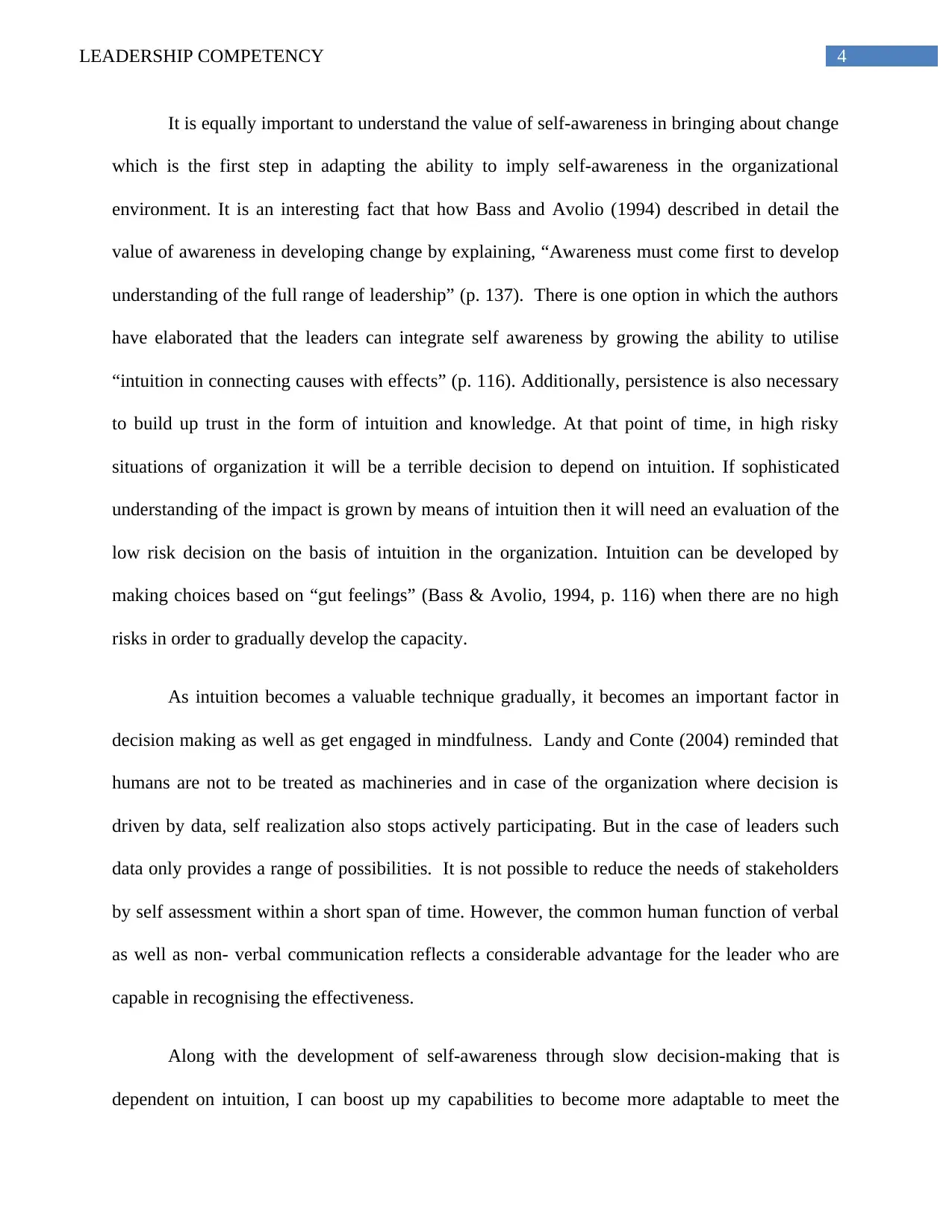
4LEADERSHIP COMPETENCY
It is equally important to understand the value of self-awareness in bringing about change
which is the first step in adapting the ability to imply self-awareness in the organizational
environment. It is an interesting fact that how Bass and Avolio (1994) described in detail the
value of awareness in developing change by explaining, “Awareness must come first to develop
understanding of the full range of leadership” (p. 137). There is one option in which the authors
have elaborated that the leaders can integrate self awareness by growing the ability to utilise
“intuition in connecting causes with effects” (p. 116). Additionally, persistence is also necessary
to build up trust in the form of intuition and knowledge. At that point of time, in high risky
situations of organization it will be a terrible decision to depend on intuition. If sophisticated
understanding of the impact is grown by means of intuition then it will need an evaluation of the
low risk decision on the basis of intuition in the organization. Intuition can be developed by
making choices based on “gut feelings” (Bass & Avolio, 1994, p. 116) when there are no high
risks in order to gradually develop the capacity.
As intuition becomes a valuable technique gradually, it becomes an important factor in
decision making as well as get engaged in mindfulness. Landy and Conte (2004) reminded that
humans are not to be treated as machineries and in case of the organization where decision is
driven by data, self realization also stops actively participating. But in the case of leaders such
data only provides a range of possibilities. It is not possible to reduce the needs of stakeholders
by self assessment within a short span of time. However, the common human function of verbal
as well as non- verbal communication reflects a considerable advantage for the leader who are
capable in recognising the effectiveness.
Along with the development of self-awareness through slow decision-making that is
dependent on intuition, I can boost up my capabilities to become more adaptable to meet the
It is equally important to understand the value of self-awareness in bringing about change
which is the first step in adapting the ability to imply self-awareness in the organizational
environment. It is an interesting fact that how Bass and Avolio (1994) described in detail the
value of awareness in developing change by explaining, “Awareness must come first to develop
understanding of the full range of leadership” (p. 137). There is one option in which the authors
have elaborated that the leaders can integrate self awareness by growing the ability to utilise
“intuition in connecting causes with effects” (p. 116). Additionally, persistence is also necessary
to build up trust in the form of intuition and knowledge. At that point of time, in high risky
situations of organization it will be a terrible decision to depend on intuition. If sophisticated
understanding of the impact is grown by means of intuition then it will need an evaluation of the
low risk decision on the basis of intuition in the organization. Intuition can be developed by
making choices based on “gut feelings” (Bass & Avolio, 1994, p. 116) when there are no high
risks in order to gradually develop the capacity.
As intuition becomes a valuable technique gradually, it becomes an important factor in
decision making as well as get engaged in mindfulness. Landy and Conte (2004) reminded that
humans are not to be treated as machineries and in case of the organization where decision is
driven by data, self realization also stops actively participating. But in the case of leaders such
data only provides a range of possibilities. It is not possible to reduce the needs of stakeholders
by self assessment within a short span of time. However, the common human function of verbal
as well as non- verbal communication reflects a considerable advantage for the leader who are
capable in recognising the effectiveness.
Along with the development of self-awareness through slow decision-making that is
dependent on intuition, I can boost up my capabilities to become more adaptable to meet the
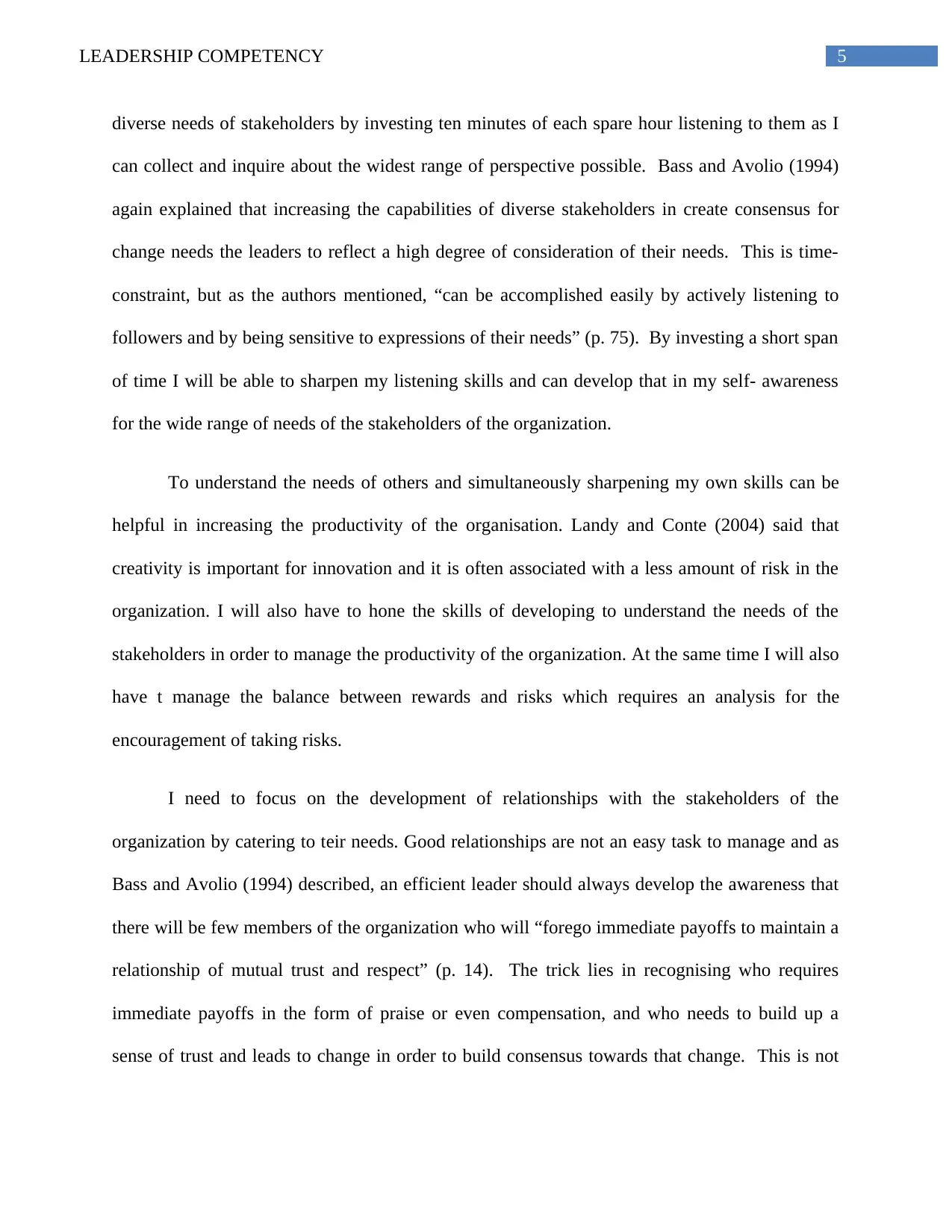
5LEADERSHIP COMPETENCY
diverse needs of stakeholders by investing ten minutes of each spare hour listening to them as I
can collect and inquire about the widest range of perspective possible. Bass and Avolio (1994)
again explained that increasing the capabilities of diverse stakeholders in create consensus for
change needs the leaders to reflect a high degree of consideration of their needs. This is time-
constraint, but as the authors mentioned, “can be accomplished easily by actively listening to
followers and by being sensitive to expressions of their needs” (p. 75). By investing a short span
of time I will be able to sharpen my listening skills and can develop that in my self- awareness
for the wide range of needs of the stakeholders of the organization.
To understand the needs of others and simultaneously sharpening my own skills can be
helpful in increasing the productivity of the organisation. Landy and Conte (2004) said that
creativity is important for innovation and it is often associated with a less amount of risk in the
organization. I will also have to hone the skills of developing to understand the needs of the
stakeholders in order to manage the productivity of the organization. At the same time I will also
have t manage the balance between rewards and risks which requires an analysis for the
encouragement of taking risks.
I need to focus on the development of relationships with the stakeholders of the
organization by catering to teir needs. Good relationships are not an easy task to manage and as
Bass and Avolio (1994) described, an efficient leader should always develop the awareness that
there will be few members of the organization who will “forego immediate payoffs to maintain a
relationship of mutual trust and respect” (p. 14). The trick lies in recognising who requires
immediate payoffs in the form of praise or even compensation, and who needs to build up a
sense of trust and leads to change in order to build consensus towards that change. This is not
diverse needs of stakeholders by investing ten minutes of each spare hour listening to them as I
can collect and inquire about the widest range of perspective possible. Bass and Avolio (1994)
again explained that increasing the capabilities of diverse stakeholders in create consensus for
change needs the leaders to reflect a high degree of consideration of their needs. This is time-
constraint, but as the authors mentioned, “can be accomplished easily by actively listening to
followers and by being sensitive to expressions of their needs” (p. 75). By investing a short span
of time I will be able to sharpen my listening skills and can develop that in my self- awareness
for the wide range of needs of the stakeholders of the organization.
To understand the needs of others and simultaneously sharpening my own skills can be
helpful in increasing the productivity of the organisation. Landy and Conte (2004) said that
creativity is important for innovation and it is often associated with a less amount of risk in the
organization. I will also have to hone the skills of developing to understand the needs of the
stakeholders in order to manage the productivity of the organization. At the same time I will also
have t manage the balance between rewards and risks which requires an analysis for the
encouragement of taking risks.
I need to focus on the development of relationships with the stakeholders of the
organization by catering to teir needs. Good relationships are not an easy task to manage and as
Bass and Avolio (1994) described, an efficient leader should always develop the awareness that
there will be few members of the organization who will “forego immediate payoffs to maintain a
relationship of mutual trust and respect” (p. 14). The trick lies in recognising who requires
immediate payoffs in the form of praise or even compensation, and who needs to build up a
sense of trust and leads to change in order to build consensus towards that change. This is not
⊘ This is a preview!⊘
Do you want full access?
Subscribe today to unlock all pages.

Trusted by 1+ million students worldwide
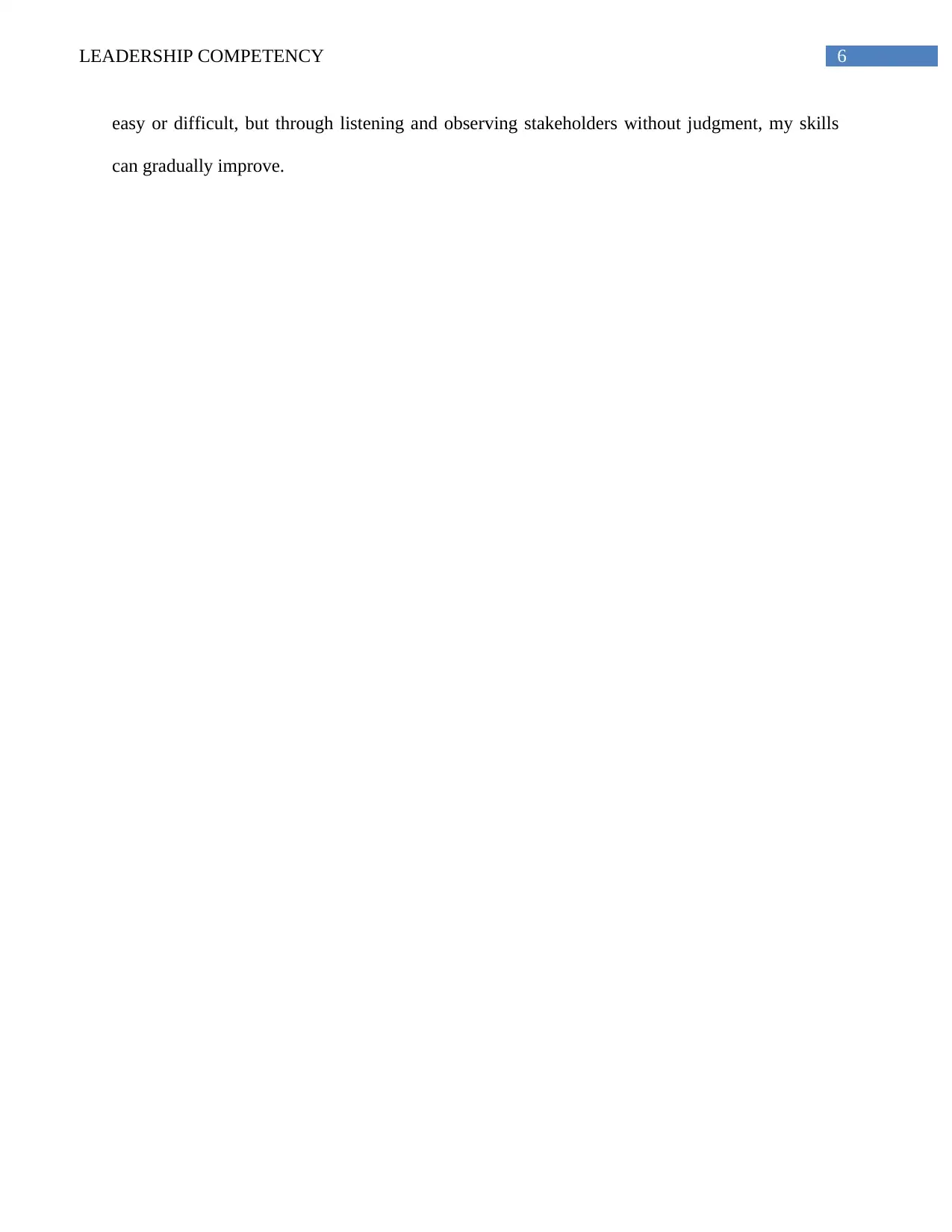
6LEADERSHIP COMPETENCY
easy or difficult, but through listening and observing stakeholders without judgment, my skills
can gradually improve.
easy or difficult, but through listening and observing stakeholders without judgment, my skills
can gradually improve.
Paraphrase This Document
Need a fresh take? Get an instant paraphrase of this document with our AI Paraphraser
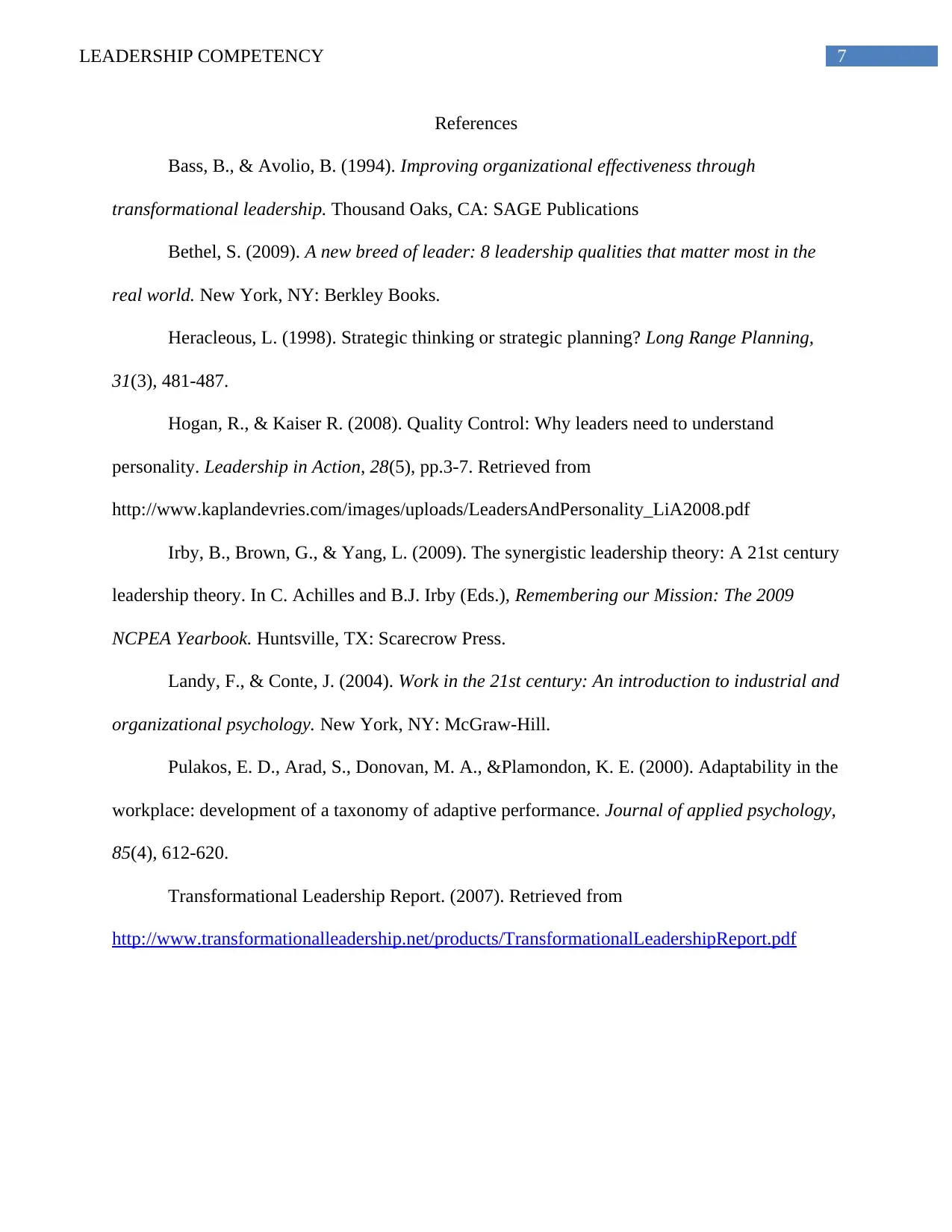
7LEADERSHIP COMPETENCY
References
Bass, B., & Avolio, B. (1994). Improving organizational effectiveness through
transformational leadership. Thousand Oaks, CA: SAGE Publications
Bethel, S. (2009). A new breed of leader: 8 leadership qualities that matter most in the
real world. New York, NY: Berkley Books.
Heracleous, L. (1998). Strategic thinking or strategic planning? Long Range Planning,
31(3), 481-487.
Hogan, R., & Kaiser R. (2008). Quality Control: Why leaders need to understand
personality. Leadership in Action, 28(5), pp.3-7. Retrieved from
http://www.kaplandevries.com/images/uploads/LeadersAndPersonality_LiA2008.pdf
Irby, B., Brown, G., & Yang, L. (2009). The synergistic leadership theory: A 21st century
leadership theory. In C. Achilles and B.J. Irby (Eds.), Remembering our Mission: The 2009
NCPEA Yearbook. Huntsville, TX: Scarecrow Press.
Landy, F., & Conte, J. (2004). Work in the 21st century: An introduction to industrial and
organizational psychology. New York, NY: McGraw-Hill.
Pulakos, E. D., Arad, S., Donovan, M. A., &Plamondon, K. E. (2000). Adaptability in the
workplace: development of a taxonomy of adaptive performance. Journal of applied psychology,
85(4), 612-620.
Transformational Leadership Report. (2007). Retrieved from
http://www.transformationalleadership.net/products/TransformationalLeadershipReport.pdf
References
Bass, B., & Avolio, B. (1994). Improving organizational effectiveness through
transformational leadership. Thousand Oaks, CA: SAGE Publications
Bethel, S. (2009). A new breed of leader: 8 leadership qualities that matter most in the
real world. New York, NY: Berkley Books.
Heracleous, L. (1998). Strategic thinking or strategic planning? Long Range Planning,
31(3), 481-487.
Hogan, R., & Kaiser R. (2008). Quality Control: Why leaders need to understand
personality. Leadership in Action, 28(5), pp.3-7. Retrieved from
http://www.kaplandevries.com/images/uploads/LeadersAndPersonality_LiA2008.pdf
Irby, B., Brown, G., & Yang, L. (2009). The synergistic leadership theory: A 21st century
leadership theory. In C. Achilles and B.J. Irby (Eds.), Remembering our Mission: The 2009
NCPEA Yearbook. Huntsville, TX: Scarecrow Press.
Landy, F., & Conte, J. (2004). Work in the 21st century: An introduction to industrial and
organizational psychology. New York, NY: McGraw-Hill.
Pulakos, E. D., Arad, S., Donovan, M. A., &Plamondon, K. E. (2000). Adaptability in the
workplace: development of a taxonomy of adaptive performance. Journal of applied psychology,
85(4), 612-620.
Transformational Leadership Report. (2007). Retrieved from
http://www.transformationalleadership.net/products/TransformationalLeadershipReport.pdf
1 out of 8
Your All-in-One AI-Powered Toolkit for Academic Success.
+13062052269
info@desklib.com
Available 24*7 on WhatsApp / Email
![[object Object]](/_next/static/media/star-bottom.7253800d.svg)
Unlock your academic potential
Copyright © 2020–2025 A2Z Services. All Rights Reserved. Developed and managed by ZUCOL.


